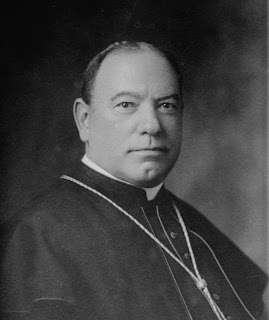Described as a “battleship in full sail,” O’Connell developed a wide public role for a self-assertive form of American Catholicism. He announced Boston Catholicism’s coming of age with his famous line “The Puritan has passed, the Catholic remains.” He was a major public figure, known among legislators as “Number One.” When Mayor James Curley supported a measure against child labor in the 1920’s, O’Connell’s opposition (on the basis that it violated parental rights) forced Curley to recant.
O’Connell had a nasty side. When he took over as Archbishop, he got rid of the Sulpicians from the seminary faculty. (He had a grudge against them from his own seminary days.) In addition, he exhumed their graves from the cemetery. But perhaps the biggest scandal of O’Connell’s career was one that never hit the papers.
It seems that his nephew Monsignor James O’Connell, whom he appointed Chancellor at a very young age, was leading a double life. He was secretly married to a woman in New York and was embezzling from archdiocesan funds to support his lavish lifestyle. The Cardinal was aware of the scandal for several years before he was forced to act by the Vatican. Several local bishops who disliked O’Connell (he was never very popular among his peers) hired a private detective to follow the nephew to New York and obtain a copy of the marriage license, which they sent to the Pope. His standing with Rome was never the same after this incident. James left both the priesthood and the Church and moved to New York where he lived with his wife. Nonetheless James O’Toole, O’Connell’s premier biographer, writes that the Cardinal “provided Catholics with a visible symbol for their full participation in American life.”












